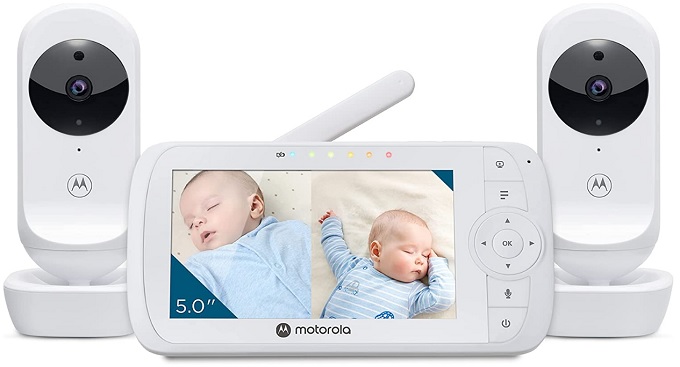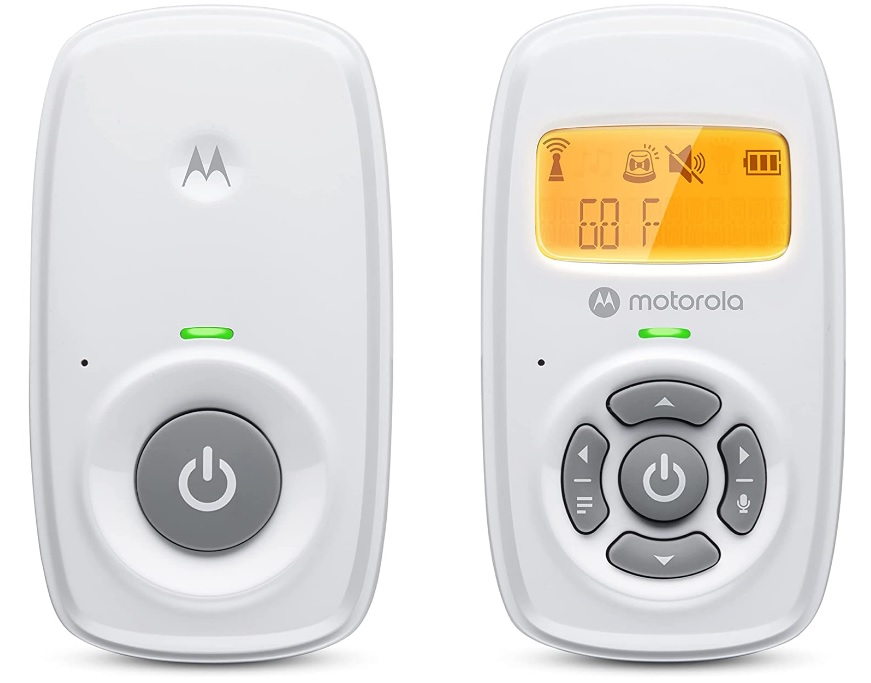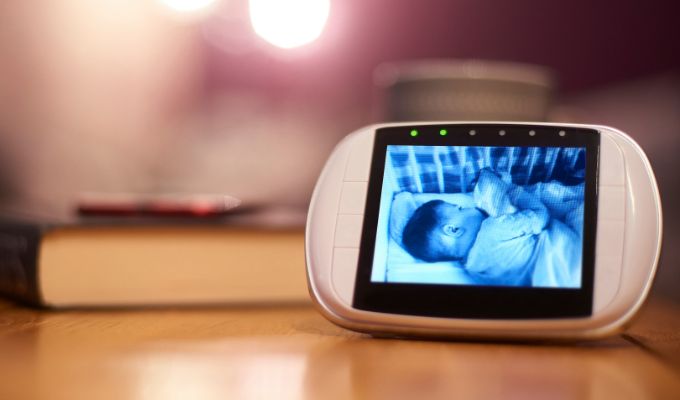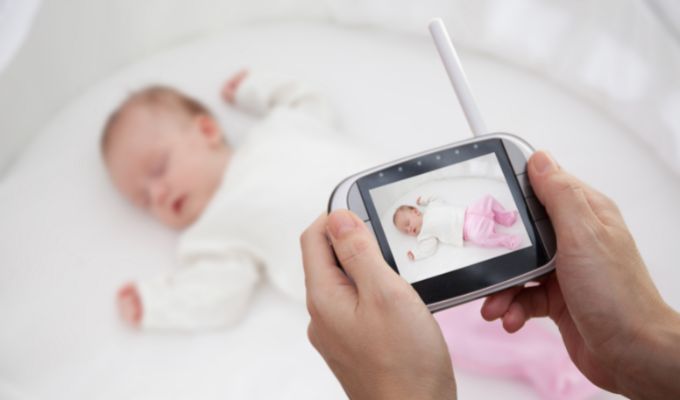Being a parent is one of the most wonderful but also one of the most difficult things in the world to do. This is especially true when your child is still a baby, it’s a time when you need to have very watchful eyes and ears over their every move. Luckily, innovative individuals created baby monitors, which has made the job of parenting at least a little easier.
Baby monitors come in different shapes & sizes and have various features. They range from very small devices that simply allow you to listen via a remote speaker all the way to more advanced units that allow full two-way audio and video capabilities.
With all the recent advancements in technology and the wide array of baby monitor models on the market, it can be difficult to know which one will work best for you.
However, with this handy baby monitor buying guide, you’ll learn everything you need to know about these smart little devices, and we make your purchase decision even easier for parents with the best-rated camera and motion baby monitor picks for 2023.
Top Pick: Motorola VM35-2 Video Baby Monitor

After extensively poring over product specs, reviews and customer feedback and applying our own selection criteria, we’ve chosen the multi-award-winning Motorola VM35-2 Digital Video Monitor best buy for 2023.
At under £200, it’s reasonably priced and is made by Motorola, a highly-regarded telecommunications company well-positioned to design what is, technically speaking, a two-way wireless audio and video communications device.
Transmission and Communication Technology
The Motorola VM35-2 transmits at 2.4 GHz over FHSS – a fancy way of saying that, in spite of using a base frequency identical to that found on many cordless phones and wireless routers, the monitor rapidly switches between other frequencies, virtually eliminating the possibility of unwanted interference.
For an extra measure of security, the monitor’s signal is encrypted, preventing accidental transmission or electronic snooping.
And at 300 meters, the Motorola VM35-2’s range should suffice for all but the largest homes – but just in case you’ve moved beyond that range or encountered unexpected signal loss, the monitor will sound an alarm – there’s no need to worry about having stepped too far away.
Motorola’s VM35-2 can play five polyphonic (multiple simultaneous notes) lullabies and features two-way communication, made possible by the high-quality speaker and microphone that allow you to clearly hear and be heard by your baby. And the full-colour screen, at 5″, is perfectly-sized, large enough to see, and small enough to fit almost anywhere or transport from room to room.
Monitoring Features
Not only does the Motorola VM35-2 feature infrared technology – the transmitter’s integrated room temperature sensor sends data to the receiver, letting you monitor your baby’s space and adjust the temperature accordingly.
Additionally, the camera’s remote-controlled pan, tilt and zoom, and extra-wide 300-degree viewing angle ensure a full view of the nursery at all times – even if your little one is active and rolls, crawls or walks out of the camera’s already excellent range.
Should you be unable to clearly see the screen or your living space is loud, you can rely on the VM35-2’s responsive lighting system: five LEDs, ranging from green to amber to red, illuminate according to noise levels, providing a simple, effective visual representation of nursery noise levels.
And though the included camera provides an impressive field of view, additional cameras may be added, allowing you to monitor other parts of the nursery.
Read More: Best Cot Bed Mattress for Baby Size 140 x 70
Best on a Budget: Motorola AM24 / MBP24 Digital Audio Baby Monitor

At around £20, the Motorola AM24 Digital Audio Baby Monitor is a fantastic, budget-friendly monitor. Though audio-only, it’s a reliable, quality product with useful features and makes the cut as a no-frills, high-value monitoring system.
Transmission and Communication Technology
Though not as advanced as the frequency-hopping FHSS technology found in Motorola’s AM24 / MBP24 baby monitor, the AM24’s 1.8 GHz DECT transmitting frequency is unlikely to cause or receive interference from other wireless devices whilst offering good resistance to signal attenuation and degradation. A feature shared with the MBP36S is data encryption, keeping the stream of your baby’s activity safe and secure.
The high-sensitivity microphone and well-tuned, high-volume speaker (easily adjusted with two large volume control buttons) ensure clear reception and sound transmission, while five responsive LEDs—arranged in a pleasing yellow-orange-red gradation—provide a visual indication of sound levels in the baby’s room. When nighttime comes, a low-light amber-coloured LED provides a soft, comforting glow.
Range and Power Options
Though the AM24’s stated range is 50 meters, some users report a working range of over 200 meters. It is, of course, best to treat a monitor’s range conservatively and use the device accordingly. Fortunately, the MBP8 features an out-of-range warning – you’ll be alerted if the receiver is too far away.
The Motorola AM24 can be plugged into a mains outlet for daily use. There are no unsightly cables, the unit sits flat against the wall, which not only looks good but keeps it out of harm’s way. If an outlet is unavailable or an outage occurs, the rechargeable battery should provide between twelve and fourteen hours of power, thanks to the battery-sparing ECO mode.
Next: Tips to Help Your Baby Fall Asleep
What Makes a Good Baby Monitor?

Sound Quality
Good sound quality is important, particularly in an audio-only or combination audio and video monitor system. You need to be able to hear your baby clearly. A monitor’s sound quality is determined by a number of factors:
Microphone quality
A good microphone is responsive but won’t easily distort at high sound pressure levels. Frequency response is especially important in the mid and high frequencies, which comprise the sound of an infant’s voice. However, a degree of low-frequency sensitivity isn’t bad – it allows other sounds – the noise of something falling, for example, to be heard.
Speaker quality
A good speaker works much like a good microphone, just in reverse. Obviously, you’re not looking for a full-range hi-fi speaker, but it’s important that sounds are transmitted clearly, and that the speaker is capable of overcoming normal levels of background noise.
Type of transmission
Test a new baby monitor in every room of your house – not just to determine the overall acoustic quality of the device, but for interference, and the effect of physical barriers, such as furniture and walls, on signal strength.
Virtually all baby monitors are wireless and transmit and receive analogue or digital signals. The former is an older technology and may be more susceptible to signal degradation and interference. The latter, especially if it transmits at a frequency not commonly used by other appliances, is more secure and less prone to interference.
A digital baby monitor that uses DECT (digitally enhanced cordless telecommunication) or FHSS (frequency-hopping spread spectrum) technology is a good choice for most purposes.
More: When Does Child Sleep Regression Start and End?
Signal Range
Before buying a baby monitor, check its specified range, and measure the distance from the nursery to the room or rooms where the receiving unit will be used. It’s important that the signal remains clear. A range of 50 to 200 meters is suitable for most homes – but measure first, and bear in mind that some homes may have thicker walls or metallic insulation that can decrease a monitor’s effective range.
Audio and visual features
In addition to the aforementioned responsive lighting found on many audio-only monitors, you may wish to look for other features, such as a battery-sparing mode which deactivates the monitor until the sound is detected by the receiver and a nightlight mode that provides gentle light when the nursery is dark.
Consider a combination audio-video monitor that features infrared (“night vision”) technology, which allows you to see your baby in a dark or dimly lit room. A non-adjustable video camera may suffice. However, a system whose camera provides a wide viewing angle and can be zoomed, panned and tilted remotely is preferable – it allows you to track your baby’s movements and can be placed in more positions than a non-adjustable camera.
Some monitors play lullabies or soothing nature sounds and allow for two-way communication, letting you speak to your baby from a distance. Research shows that verbal (spoken) and non-verbal (gentle sound and noise) communication is extremely important to a young person’s development.
Smartphone connectivity
Though not an essential feature, some video baby monitors include smartphone connectivity. Such monitors transmit video and audio streams to your connected devices over Wi-Fi or 3G/4G/5G data, making it possible to control the monitor, track events, and see and listen to your baby on a smartphone, tablet or computer.
Power source (battery and mains)
A baby monitor, of course, uses electricity. If the power goes out, so too does a mains-powered monitor. Fortunately, some models run on both mains electricity and batteries – if there’s an outage, you’ll still be able to check on your baby.
Battery life and the type of batteries used can vary from model to model. Therefore, it’s important to pay attention to how long the batteries will last and how long it takes to recharge them.
Look for a monitor whose batteries are rechargeable, and hold enough power to last at least half a day. When choosing a mains-powered unit – even one with a backup battery – look for a model that plugs directly into an outlet, flush against the wall. You’ll appreciate the lack of messy cables.
Build Quality and Brand Reputation
A baby monitor isn’t just a gadget – it’s a connection to your baby and a tool to help ensure their wellbeing. That’s why choosing a high-quality monitor from a well-regarded manufacturer is important. In fact, telecommunications companies, with their expertise in audio, video and wireless technologies – make some of the best baby monitors on the market.
Out-of-range alert
It’s a good idea to select a baby monitor that provides an out-of-range alert. An audible or visual alert is provided if the monitor’s receiver has moved beyond the transmitter’s range. Consider it a safety feature that keeps you within a reliable monitoring distance of your baby.
Baby Monitor Price Range
When most of us set out to purchase a product we need, we typically have a certain budget in mind. This is a very important step in purchasing a baby monitor as the price range can vary wildly from one model to another.
Depending on the brand, features and quality, baby monitors can range in price from only £20 all the way to over £200. You don’t have to set your mind on an exact price, but you should have an idea of a general range that is a comfortable budget and shop for deals.
Types of Baby Monitors
Before we discuss the long list of various features available, it’s important to understand the different types of monitors available. Choosing a particular type before you begin shopping will help you save time on research and more easily compare additional features and quality.
There are two types of baby monitors: Audio and video. The former is simplest but requires that the listening environment be suitably quiet (or the monitor sufficiently loud). The latter often allows you to see and hear your baby, negating the need for a quiet space. Naturally, a dual audio-video monitor will cost more than its audio-only counterpart.
It’s worth noting that many audio-only baby monitors incorporate responsive, variable-brightness lighting. While no replacement for a live video feed, it provides a visual alert when a baby cries or in the event of other noises within the microphone’s range. Some video monitors come with large screens; others are small size, but that isn’t a disadvantage if you’re short on space.
Audio Only Models
Audio-only models do not offer any video capabilities, and their core function is to operate either as a one-way or two-way remote microphone and speaker system. One-way monitors allow you to only listen to any noises your child might be made via a remote speaker. Two-way systems allow you to listen to your child but also speak through a remote mic/speaker so your child can hear your voice.
Audio and Video Capable Models
Models that offer audio and video capability are often designed as two-way systems that allow you to listen, speak and watch your child via a remote monitor, microphone and speaker. These baby monitors offer the most convenience and typically have more features but come with a higher price tag. It’s also important to note that different models offer video quality ranging from very low-quality resolution to excellent high-definition options.
Baby Monitor Features
A baby monitoring system’s individual features are one of the most important aspects of making a good purchasing decision. Some features are essential for keeping your child safe, and others are essential for adding convenience to your monitoring duties. The necessary features will largely depend on your lifestyle, personal preferences and how many children you need to monitor at once.
Below is a list of the core features available with various baby monitor models that may be important considerations for ensuring a particular unit is a good fit for your needs.
Wi-Fi Capable Monitors
Many baby monitors use a 1.9GHz or 2.4GHz signal to transmit audio and video from one monitor to another. While this is efficient, it limits how far away the receiving monitor can be from the baby monitor in your child’s room or location.
If you choose a monitor that is capable of connecting to your home wireless network, you can receive audio and video from the location of your child to literally anywhere you are in the world, as long as you have an internet connection.
There are variations in the equipment used for this type of monitor. Some still require you to use two monitors, one in your child’s location and one for you to view and listen on. Others allow you to view and listen via your smartphone, tablet or laptop.
Night Vision Cameras
Night Vision can be an important feature for video-capable models because it allows you to still see your child even if they are asleep in a dark room.
Activity and Motion Sensors
Activity sensors activate a monitor and transmit audio/video only when they sense sound or movement. This feature can be very helpful for preserving battery life but depending on the monitor, some sensors are much higher quality than others, so choose wisely.
Light Bars and Indicators
Some baby monitors will have light bars or LED indicators that illuminate at different brightness levels depending on the noise level they sense. This is helpful if you are in a noisy environment or want to keep the volume of the receiving monitor low while still being able to effectively monitor if your child is crying or calling out to you. Additionally, these types of indicators can let you know if there is a connectivity issue or if your batteries are getting low.
Additional Monitors and Cameras
Baby monitors are a great option for keeping a watchful eye on one child, but what if you have four children? Some baby monitors will allow you to connect additional monitors and cameras to the base system in the event you need to monitor more than one child. This can also be handy if you want to leave a receiving unit in your bedroom while carrying an extra unit with you as you move around the other areas of your home.
Baby Monitor Buying Tips
By now, you should at least be aware of the core features and types of baby monitors that are available on the market. As stated above, they come with a wide variety of models, all with different features and capabilities. However, part of choosing the right model for your needs is taking into consideration a few things about your lifestyle and situation.
How much time you spend away from home and where or how you will primarily be doing your monitoring duties can make certain features essential to choosing the right monitoring system. Below are just a few of the key considerations you should consider before making a final choice on which baby monitor will fit your lifestyle best.
Key Considerations:
- How much do you travel?
- Do you need audio only or audio and video capabilities?
- Is night vision important to you?
- Will you be monitoring only at home, or do you need Wi-Fi connectivity for remote monitoring with an app and smartphone?
- What do previous customers say about the product’s quality?
- What features are the most important to you?
- Do you need a motion sensor mat for a wriggly baby?
While the considerations above are important for finding a baby monitor with the most important features and still fits within your budget, some people want a monitoring system that offers full functionality without limitations.
The Motorola Baby Monitoring System fits this description perfectly, as its features and capabilities are one of the most comprehensive combinations available.
It’s an expandable system that comes with a digital display unit, is fully internet capable, can connect to a TV or DVD player, is easily portable and offers a full set of advanced features. This baby monitor is certainly not among the least expensive units, but if you are looking for a high-quality device with advanced features, then it should be on your list of considerations


